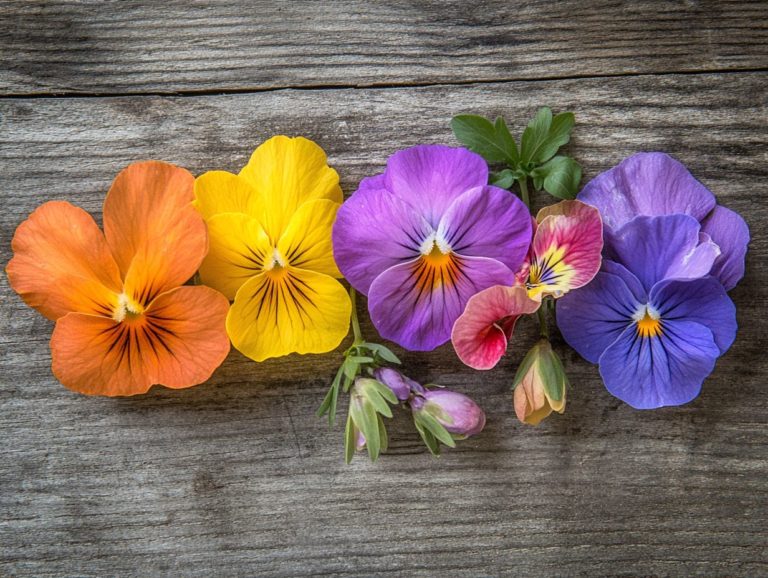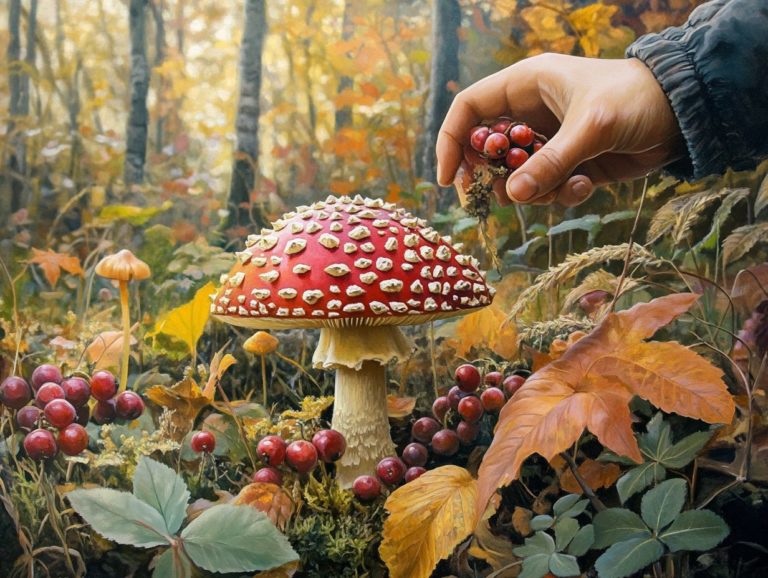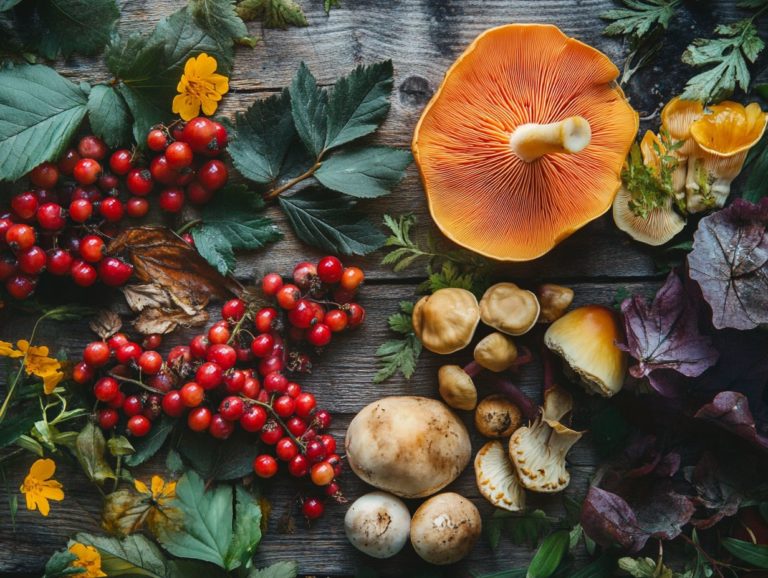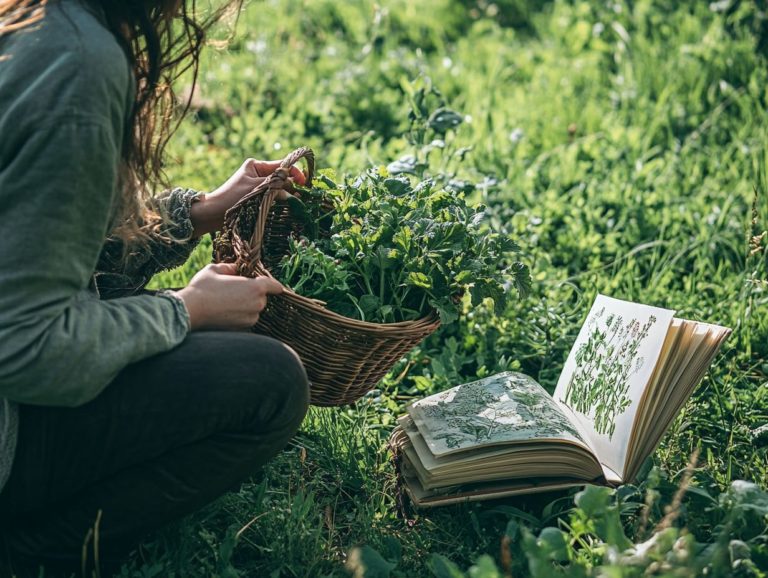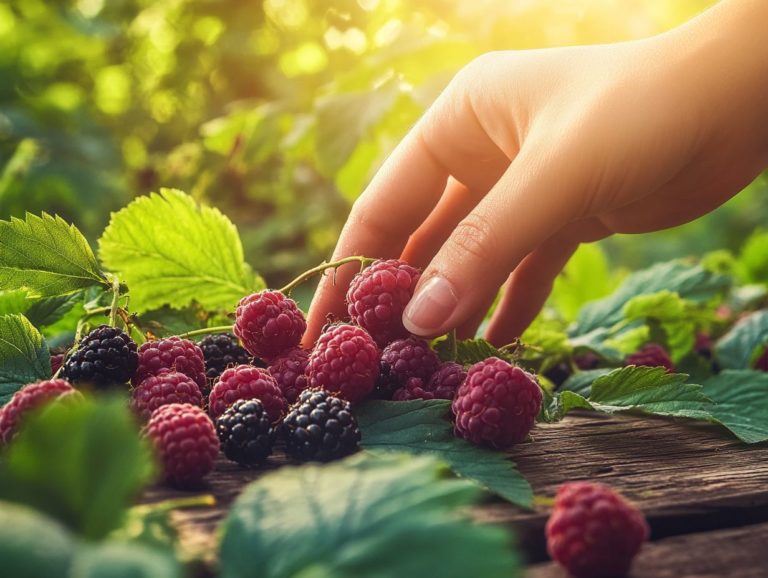Exploring Seasonal Edibles in Forested Areas
Seasonal edibles are nature’s wonderful options, presenting a rich tapestry of flavors and health benefits that evolve with each season.
This guide illuminates the nutritional advantages and environmental significance of sourcing these natural treasures. You will uncover essential tools and techniques for safe harvesting, accompanied by enticing recipes that transform your finds into delightful meals. We will also explore sustainable foraging practices, ensuring the preservation of our precious ecosystems. Get ready for an exciting adventure discovering seasonal edibles!
Contents
- What You’ll Discover:
- Benefits of Foraging for Seasonal Edibles
- Identifying and Harvesting Seasonal Edibles
- Preparation and Cooking of Seasonal Edibles
- Sustainable Foraging Practices
- Frequently Asked Questions
- What are seasonal edibles in forested areas?
- Why is it important to know about seasonal edibles in forested areas?
- How can I identify seasonal edibles in forested areas?
- What precautions should I take when foraging for seasonal edibles in forested areas?
- What are some common examples of seasonal edibles in forested areas?
- Are there any potential dangers when foraging for seasonal edibles in forested areas?
What You’ll Discover:
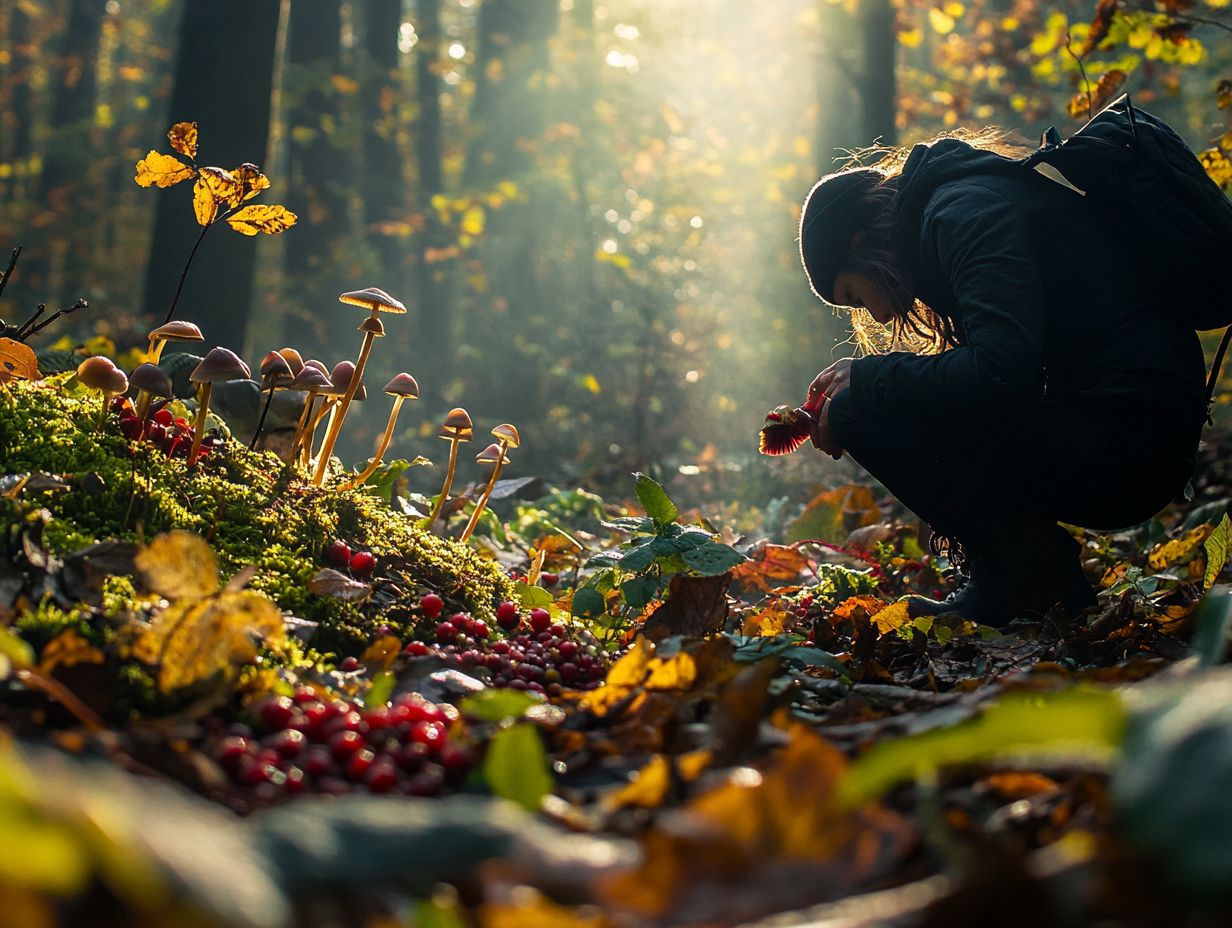
- Seasonal edibles are plants found in forested areas that can be safely foraged and consumed for their nutritional and environmental benefits.
- Foraging for seasonal edibles not only provides access to fresh and healthy food but also promotes sustainable practices and helps maintain forest ecosystems.
- Identify and harvest seasonal edibles safely with the right tools and techniques, and learn how to prepare and cook them in delicious meals.
What are Seasonal Edibles?
Seasonal edibles present you with a delightful array of wild foods ripe for harvest throughout the year. Think nutrient-rich options like mallow leaves, dandelion leaves, and fresh ramps. These wild foods aren’t just tasty; they connect you to nature’s bounty and invite you to explore a guide to seasonal foraging in your area, encouraging creativity in the kitchen with edible plants and fruits like wild blackberries and prickly pears.
Foraging culture flourishes on the wisdom of these seasonal cycles, celebrating the rich diversity of edible plants that emerge as the months change. From the vibrant sprouts of early spring to the robust roots and berries of the fall, each season reveals its unique treasures.
By weaving seasonal edibles into your daily meals, you cultivate a sustainable lifestyle. This reduces reliance on commercial agriculture.
This connection to local flora not only boosts your nutritional well-being but also deepens your appreciation for the environment and the intricate web of life surrounding you, making every foraging experience truly unforgettable.
Benefits of Foraging for Seasonal Edibles
Foraging for seasonal edibles offers you a wealth of benefits, from enhancing your nutrition with fresh ingredients loaded with vitamin C to fostering a sense of community as you engage in sustainable foraging practices. Learning about identifying wild edibles in your local area allows us to gather food without harming the environment.
By mastering effective cooking techniques, you can elevate these harvested treasures into exquisite elderberry recipes and other culinary delights that truly celebrate local biodiversity.
Nutritional and Environmental Benefits
The nutritional and environmental benefits of foraging for wild edibles are truly remarkable. By exploring the great outdoors, you unlock a treasure trove of diverse vitamins, minerals, and unique flavor profiles. Think morel mushrooms, turkey tail, and stinging nettle; these aren’t just nutrient-rich; they also play a vital role in protecting edibles and ecosystems.
When you incorporate these wild plants into your diet, you enhance your intake of essential nutrients that you might miss in processed foods. Foraging promotes dietary diversity, which is crucial for your overall health and wellness. On the environmental front, harvesting wild edibles creates a deeper connection to nature and helps promote biodiversity by encouraging the growth of native plants.
Foraging lowers your carbon footprint. By gathering food from the wild, you reduce your reliance on mass-produced agriculture, which often comes with hefty transportation emissions. Ultimately, embracing wild edibles nourishes not just your body but also supports the health of our planet.
Identifying and Harvesting Seasonal Edibles
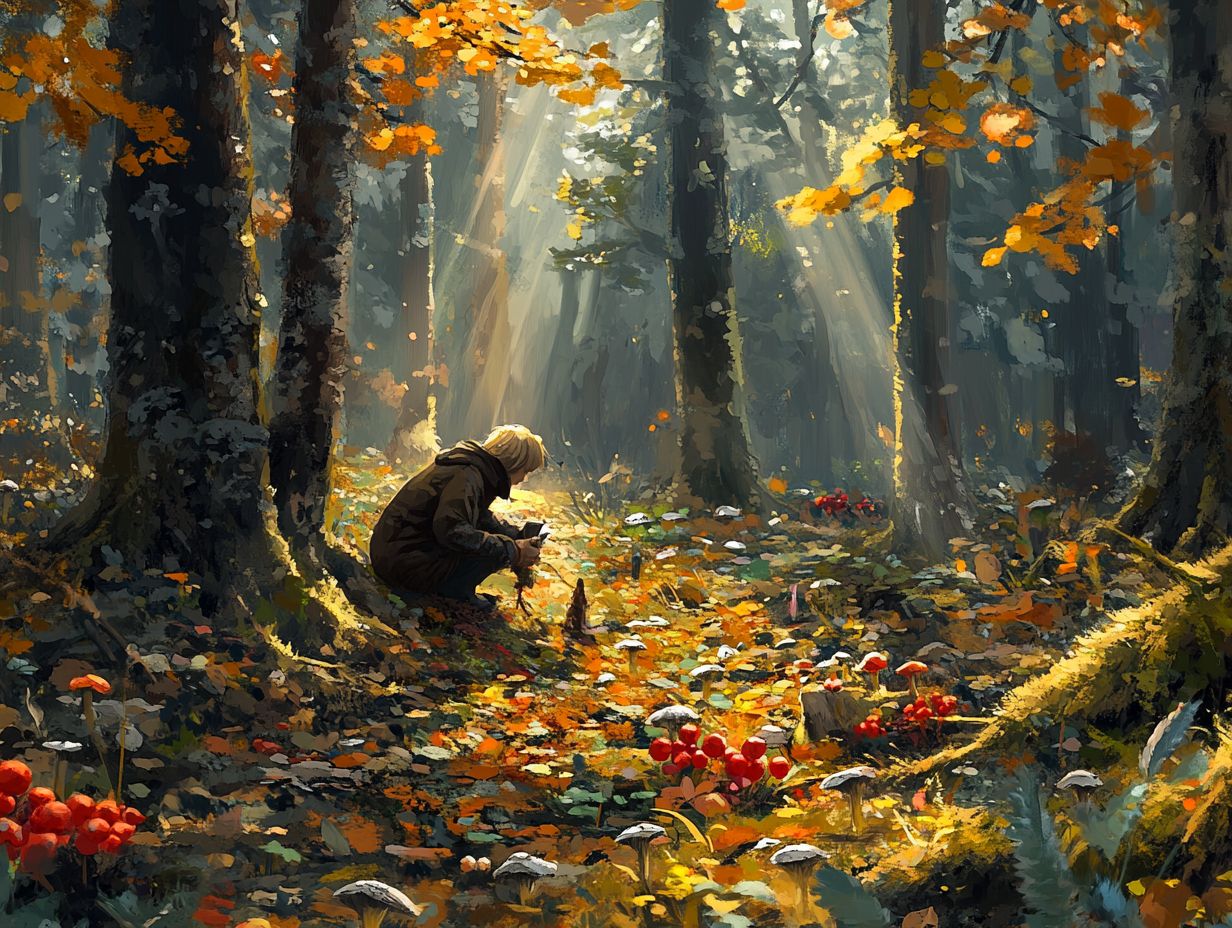
Successfully identifying and harvesting seasonal edibles demands a blend of knowledge and practice, enabling you to distinguish between delectable finds like ramps and California chanterelles and their inedible or toxic counterparts. For a comprehensive overview, refer to the guide on identifying wild edibles throughout the year.
By employing effective harvesting tips, you can elevate your foraging experience. This ensures that the bounty you collect nourishes both your cooking projects and the surrounding wild ecosystems.
Tools and Techniques for Safe Foraging
Equipping yourself with the right foraging tools and safe techniques is crucial for a successful adventure. It enhances your ability to identify and collect wild edibles like wildflowers and mushrooms.
Essential tools include:
- A sturdy basket for gathering your finds.
- A reliable field guide for accurate identification.
- A sharp knife for careful harvesting these can truly elevate your foraging experience.
Learn about sustainable practices to protect our planet! It’s vital to take only what you need, promoting ecological balance in the process.
Sharing insights helps enrich your personal foraging journey and strengthens the collective wisdom. Organizations frequently host workshops, providing valuable resources for newcomers eager to dive into this rewarding activity.
Engaging with fellow enthusiasts can lead to the discovery of hidden gems in nature and enhance your foraging skills as a group.
Preparation and Cooking of Seasonal Edibles
Preparation and cooking of seasonal ingredients require a range of techniques that elevate their natural flavors and textures. This enables you to craft exquisite dishes, from rustic desserts to vibrant grain bowls.
By grasping the flavor profiles of wild mushrooms and other seasonal elements, you can transform your home-cooked meals into extraordinary culinary experiences.
Recipes and Tips for Delicious Meals
Creating delicious meals with seasonal ingredients is an exhilarating culinary journey. Imagine whipping up recipes that feature fresh delights like wild blackberries, phyllo dough, and invigorating lemon juice.
These vibrant components enable you to experiment with unique flavor combinations, resulting in truly inspiring dishes. These ingredients not only elevate taste but also bring a treasure trove of nutritional benefits to your table.
For example, wild blackberries are bursting with antioxidants and vitamins, while phyllo dough adds a light, flaky texture that can transform any dish.
Fresh lemon juice, with its zesty acidity, brightens flavors and enhances balance in your meals. By embracing these seasonal treasures, you re encouraged to think creatively crafting vibrant salads, sumptuous pastries, or tangy dressings that highlight the distinctive qualities of each ingredient.
This approach opens the door to experimentation and joy in the kitchen, allowing you to create flavorful, nutritious meals that celebrate the bounty of the season.
Sustainable Foraging Practices
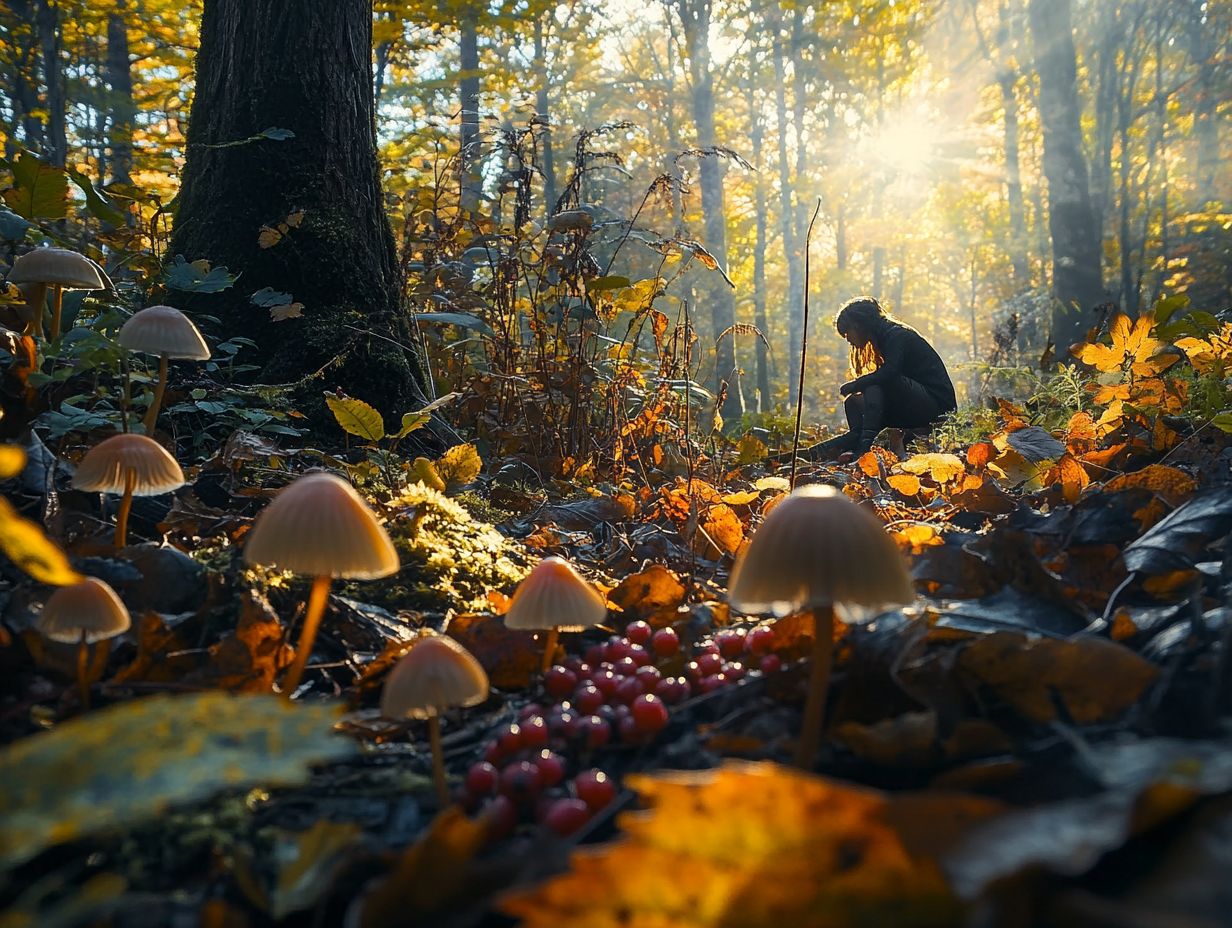
Adopting sustainable foraging practices is essential for preserving ecosystems and ensuring that wild edibles remain available for future generations. By promoting the use of plants and animals that do not harm the local ecosystem and employing responsible harvesting methods, you can contribute to community resources and enhance education on the topic.
This thoughtful approach not only nurtures the environment but also fosters a deeper connection between individuals and the natural world around them.
Act now to ensure our natural resources thrive for future generations!
Preserving and Maintaining Forest Ecosystems
Preserving and maintaining forest ecosystems is essential for you as a forager. The impact of harvesting wild herbs and other edibles directly influences biodiversity conservation and the overall health of natural habitats.
You play a crucial role in this delicate balance, acting as a steward of the land by ensuring that your practices don t deplete local flora. Biodiversity means the variety of life in an area. When you forage sustainably, you protect plant species and boost ecosystem resilience, which is the ability of an ecosystem to recover from disturbances.
Being mindful of your harvesting techniques helps you contribute to the plants’ regeneration, enabling them to thrive and support various wildlife. As a passionate forager, you advocate for preserving our precious forests!
Frequently Asked Questions
What are seasonal edibles in forested areas?
Seasonal edibles are plants and mushrooms that are only available at certain times of the year, typically in the spring, summer, or fall, making summer foraging adventures an exciting way to explore local areas.
Why is it important to know about seasonal edibles in forested areas?

Knowing about seasonal edibles in forested areas can help you identify and harvest edible plants and mushrooms while exploring nature. Additionally, foraging in urban environments can provide you with a sustainable food source and a deeper connection to the environment.
How can I identify seasonal edibles in forested areas?
It is important to have a good field guide and/or the assistance of an experienced forager to help you properly identify seasonal edibles in forested areas. For more detailed information, consult finding edibles in your local area. Relying solely on online sources or personal knowledge is not recommended, as misidentification can be dangerous.
What precautions should I take when foraging for seasonal edibles in forested areas?
Always make sure to properly identify any plant or mushroom before consuming it. Wash and cook all foraged edibles to reduce the risk of potential contamination. It is also important to forage sustainably, only taking what you need and leaving enough for the plant or mushroom to continue growing.
What are some common examples of seasonal edibles in forested areas?
Some common examples include morel mushrooms, fiddlehead ferns, wild berries, and ramps (wild leeks). However, the availability of these seasonal edibles may vary depending on your location and the specific season, so it’s important to know what to know about seasonal foraging in your area.
Are there any potential dangers when foraging for seasonal edibles in forested areas?
Yes, there are potential dangers when foraging. These include misidentification, contamination, and interactions with prescription medications. It is important to do thorough research and consult with an expert before consuming any foraged edibles.
Join the movement to protect our forests and enjoy the bounty they offer!

